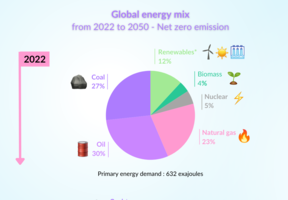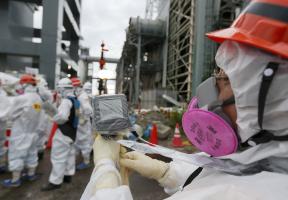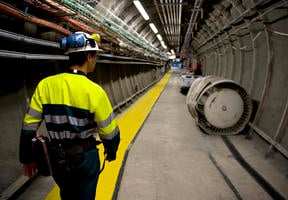About Nuclear Fusion
5 min read
is a natural phenomenon in stars: the Sun, for example, unleashes huge amounts of energy every second. But reproducing and taming it here on Earth poses many challenges. The main one is replicating the extreme temperatures and magnetic fields needed.

© AFP - A virtual image of the future ITER reactor's confinement vessel.
In nuclear fusion, two or more light atomic nuclei collide and merge (“fuse”) to form a heavier nucleus. It differs from , used in nuclear plants, where very heavy nuclei are broken apart.
A Solar Phenomenon…
The Sun turns 600 million tons of
into heavier helium every second,1 releasing a massive amount of energy. This is made possible by the extreme temperatures in the Sun’s core — millions of degrees.
During fusion, hydrogen forms plasma, a hot, electrically charged gas that is the fourth state of matter. The atomic nuclei in the plasma shed their electrons. Although the natural repulsion between them is very high, some atoms fuse to produce helium, releasing enormous amounts of energy in the process. In the Sun, the probability that two hydrogen nuclei will fuse is extremely low, but this is offset by the huge numbers of nuclei present.
... Difficult to Reproduce on Earth
Uncontrolled nuclear fusion has been achieved, with the infamous hydrogen bomb (H-bomb). Controlled, self-sustaining nuclear fusion has not.
The first requirement is extremely high temperatures — up to 200 million degrees. The problem is that no material can withstand this temperature. Researchers working to reproduce nuclear fusion are mainly focusing on magnetic confinement. This involves using intense magnetic fields to contain and control the very hot plasma in an annular space.2
To increase the probability of fusion, hydrogen isotopes — deuterium and tritium — are used. Isotopes are versions of the same element, with the same number of protons in their nuclei, but different numbers of neutrons.
- The deuterium (2H) is extracted from seawater.
- Tritium (3H) is not found on Earth or in the lower layers of the atmosphere. It is produced in minute quantities by fission inside conventional nuclear reactors. It can also be generated by irradiating lithium, an element that is found in abundance on Earth. Unlike deuterium, tritium has a short half-life of just 12 years. Half-life is the time it takes for the of an isotope to fall to half its original value.
Producing Energy from Fusion
Put simply, the process of producing energy from nuclear fusion consists of the following five steps:
- Plasma is placed inside a vacuum vessel, which is a hermetically sealed stainless steel container that acts as a first safety containment barrier.3 The plasma is then ionized to change the number of ions and heated by a high-intensity electrical current.
- High-energy deuterium particles are shot into the plasma regularly. Along with high-frequency electromagnetic waves and production of high-energy helium nuclei, this maintains the extremely high temperature required for a fusion reaction.
- Electrical currents circulating in the plasma and in coils outside the vacuum vessel create the intense magnetic field — 50,000 times stronger than the Earth’s — required to confine the plasma.
- Fusion releases neutrons to supply energy that is then captured. The neutrons are unaffected by the magnetic field because their electrical charge is neutral, so they escape outside the confinement vessel and bounce off the walls of the reactor, heating it until it is white-hot.
- A recovers the heat on the outside and transfers it to a secondary circuit. As in nuclear fission power plants, this circuit generates steam used to produce .
Scientists from around the world have been conducting research for more than 50 years, but still have decades of work ahead of them.
Nuclear Fusion Was Discovered by a Woman
A few decades after the work of Nobel Prize winner Marie Curie on radioactivity, another woman made a significant contribution to nuclear physics, helping to discover nuclear fusion. Austrian physicist Lise Meitner worked alongside German chemists Otto Hahn and Fritz Strassmann on research culminating in its description in 1938.






















